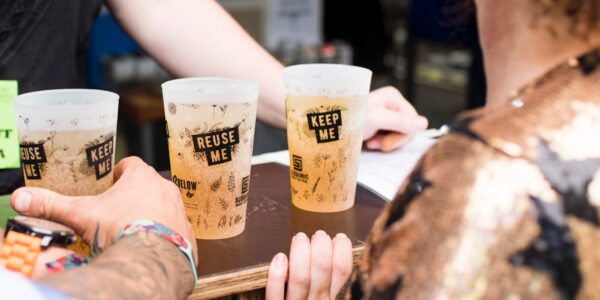Busting 5 Myths About Reusables

We get a lot of questions from our community about the safety of reusable dishes, cups, and utensils, especially as COVID-19 guidelines evolve. To unpack some commonly held misperceptions around reusables and their safety at food cart lots, events, and festivals, we met with Adrea Rodriguez-Lovejoy, MS, REHS, at Deschutes County Health Service (DCHS). Here are 5 myths we busted with Adrea, along with the facts based on state and local guidelines on the acceptable use of reusables.
MYTH #1: Disposable, single-use products are more sanitary than reusables.

Fact: As long as reusables go through the DCHS approved 3-step cleaning process, they are just as clean as (or cleaner than!) disposable dishes. The approved 3-step cleaning process occurs in all licensed food establishments. This is when the dishes are washed, rinsed and sanitized with an approved sanitizer, and then air dried prior to use and reuse.
MYTH #2: The health department does not allow guests to bring reusable cups to events.
Fact: Reusable beverage containers can be refilled if they are brought to an event in a clean condition, and filled by the employee in a contamination-free dispensing process. This means that when your container is filled, it doesn’t touch the dispensing container, so that no germs are shared.
MYTH #3: The health department does not allow customers to fill their own reusable cups.
Fact: Reusable beverage containers can be filled by the customer if there is a contamination-free dispensing process available (like a soda dispensing station).
MYTH #4: Reusable dishes are prohibited because they are unsafe.
Fact: Reusable dishes can be used safely at events and food cart lots, just like in standard restaurants. In order to protect public health, reusable dishes from private homes cannot be taken into food trucks or into the kitchen of licensed food facilities. You can, however, transfer food to a BYO dish or to-go container once the food leaves the food truck or kitchen.
MYTH #5: Compostable dishes are better for the environment. 
Fact: Not necessarily. Here are nine reasons local composters do not accept dishes, cups, utensils, and serviceware that is labeled “compostable.” The most sustainable option locally is reusable dishware. Make the choice to support businesses that offer reusable dishware, and encourage event coordinators to explore reusable options.
Reusable systems are good for the planet and for us as long as we employ basic hygiene! Want to dive into the guidelines? Here’s the exact language on returnable (aka reusable) cups and proper dispensing from the Oregon Food Sanitation Rules:
3-304.17 Refilling Returnables.
(A) Except as specified in paragraph (C) of this section, a take-home food container returned to a food establishment may not be refilled at a food establishment with a potentially hazardous food (time/temperature control for safety food).
(B) Except as specified in paragraph (C) of this section, a take-home food container refilled with non-potentially hazardous (non-TCS) food shall be cleaned as specified under paragraph 4-603.17(B).
(C) Notwithstanding paragraphs (A) and (B) of this section, personal take-out beverage containers, such as thermally insulated bottles, non-spill coffee cups, and promotional beverage glasses, may be refilled by employees or the consumer with a beverage that is a potentially hazardous food (time/temperature control for safety food) if refilling is a contamination-free process as specified under paragraphs 4-204.13(A), (B), and (D).
4-204.13 Dispensing Equipment, Protection of Equipment and Food.
In equipment that dispenses or vends liquid food or ice in unpackaged form:
(A) The delivery tube, chute, orifice, and splash surfaces directly above the container receiving the food shall be designed in a manner, such as with barriers, baffles, or drip aprons, so that drips from condensation and splash are diverted from the opening of the container receiving the food;
(B) The delivery tube, chute, and orifice shall be protected from manual contact such as by being recessed;
(C) The delivery tube or chute and orifice of equipment used to vend liquid food or ice in unpackaged form to self-service consumers shall be designed so that the delivery tube or chute and orifice are protected from dust, insects, rodents, and other contamination by a self-closing door if the equipment is:
(1) Located in an outside area that does not otherwise afford the protection of an enclosure against the rain, windblown debris, insects, rodents, and other contaminants that are present in the environment, or
(2) Available for self-service during hours when it is not under the full-time supervision of a food employee; and
(D) The dispensing equipment actuating lever or mechanism and filling device of consumer self-service beverage dispensing equipment shall be designed to prevent contact with the lip-contact surface of glasses or cups that are refilled.